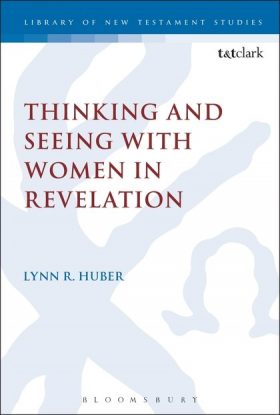In “Thinking and Seeing with Women in Revelation,” Associate Professor Lynn Huber adds to a growing body of knowledge about the way some women have interpreted the end chapter of the Bible.

But when it comes to interpreting what is considered to be among the vaguest books of the Bible, scholars have focused almost exclusively on what men have described, whether in words or art. Female interpretations of Revelation have been largely ignored, and several scholars – including an Elon University professor – are attempting to rectify that gap in knowledge.
“Thinking and Seeing with Women in Revelation” by Associate Professor Lynn Huber explains how select women in medieval times and in the late 20th century have used art to interpret the Book of Revelation, one of the most visually compelling sections of the Bible.
Published in hardcover this month by T and T Clark, the book spotlights Revelation’s female imagery, specifically the descriptions of the Prostitute and the Bride, within the context of the ancient world where cities and nations were imagined in feminine terms. Huber argues that this imagery serves as a tool for building community identity in opposition to claims of the Roman Empire.
Huber then examines artistic interpretations of Revelation later made by two medieval visionaries, Hildegard of Bingen and Hadewijch of Brabant, and two modern visionaries and visual artists, Gertrude Morgan and Myrtice West, both of whom lived in the American South.
All four women created works they claimed were inspired by visions or commands from God, and it was their interpretations of the Apocalypse – which, to be clear, is not “the end of the world” as popular culture has defined it – where Huber focused her research. The message of God’s “unveiling” is an ambiguous chapter, she said, and the author “commands” his audience to “see” the text.
“Ancient interpreters really thought it had levels and levels of meaning because it was so vague,” Huber said of the book. “Even in the earliest centuries, people debated whether Revelation should be called ‘Revelation.’ It obscured more than it revealed.”
 Divine knowledge could be conveyed with visions in the ancient world, she said, and Revelation does exactly that. “It’s a very visual text and uses images to describe realities that had not been seen before,” Huber said. “It’s so full of imagery that there’s a rich opportunity to spark the imagination.”
Divine knowledge could be conveyed with visions in the ancient world, she said, and Revelation does exactly that. “It’s a very visual text and uses images to describe realities that had not been seen before,” Huber said. “It’s so full of imagery that there’s a rich opportunity to spark the imagination.”
Because most scholarship until now has focused on interpretations made by male artists and other leading male thinkers, Huber says her work helps to rectify the tendency to focus primarily on those interpreters when studying Revelation’s messages.
She does emphasize one point in her book: “It’s hard to say there’s only one female interpretation of Revelation.”
“Women in Revelation” is Huber’s second book. She also authored “‘Like a Bride Adorned’: Reading Metaphor in John’s Apocalypse,” published in 2007 by T and T Clark, and is currently co-writing a feminist commentary on the Book of Revelation to be published by Liturgical Press.
A native of Portland, Ore., Huber earned her undergraduate degree in philosophy from Northwest Nazarene University in, Idaho. She later enrolled in a master of divinity program at the Candler School of Theology at Emory University, and after time in seminary, she pursued her doctorate in New Testament studies at Emory.
Her teaching focuses on the New Testament and early Christian history as well as courses focusing upon the emerging Christian community’s literature within the context of Second Temple Judaism. Her research focuses primarily on the Book of Revelation, as well as exploring the construction of gender, sexuality and virginity in the early Christian context, the rhetorical use of metaphor, and the ways that apocalyptic texts prompt audiences to visualize.
In 2008, Huber received the Elon College of Arts and Sciences Award for Excellence in Scholarship. She chairs the Department of Religious Studies and previously served as interim director of Elon University’s Center for the Study of Religion, Culture and Society.


